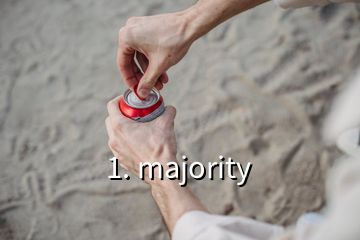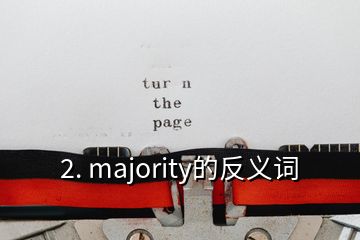1. majority

答案是,用单数形式还正确哦
2. majority的反义词

成人的英语单词是adult。;adult 英 ['ædʌlt] 美 ['ædʌlt] ;n. 成年人;成年动物;adj. 成年的;理智的;适合成年人的;成熟的;1、adult用作形容词的基本意思是“成熟的”,指人身体已经发育成熟,也可指智力及情感已成熟,用于物则指达到发展过程中的成熟阶段。;2、adult也可作“成年人的,适宜于成年人的”解,指已经度过青春期或已经达到法定年龄。;3、adult作“成年的”“成年人的”解时不用于比较等级,作“老成的”解时可用于比较等级。;扩展资料;反义词:immature、childish;一、immature 英 [ˌɪmə'tjʊə(r)] 美 [ˌɪmə'tʃʊr] ;adj. 不成熟的;例:Sows are immature for the majority of their breeding life.;母猪在它大部分繁殖过程是不成熟的。;二、childish 英 ['tʃaɪldɪʃ] 美 ['tʃaɪldɪʃ] ;adj. 孩子气的;幼稚的;例:She clapped her hands in childish glee.;她孩子气地高兴地拍着手。
3. majority翻译
立党为公 [词典] The Party is founded for public interests.; build a party for the interests of the vast majority; build a party serving the interests of the people; [例句]一是着力增强宗旨观念,切实做到立党为公、执政为民。
First, increasing the awareness of the Party's principle and working hard for the people.
4. majority的读音
the majority of+复数名词用作主语时,谓动用复数;the majority of+不可数名词用作主语时,谓动用单数。
一、the majority of释义大多数。
二、the majority of读音英 [ðə məˈdʒɒrəti ɒv],美 [ðə məˈdʒɔːrəti əv]。
三、the majority of示例:The majority of foreign nationals working here have work permits.大多数在这里工作的外国人都有工作许可证。
5. majority的形容词英文
majority词根词缀快速联想法
词根:-magn-→maj大的+中缀-or形容词词尾+后缀-ity名词词尾
n.大部分;大多数;(获胜的)票数;多数票;超出其余各方票数总和的票数;
例句
This treatment is not available in the vast majority of hospitals.
绝大部分医院都不提供这种治疗。
6. majority后面的谓语动词
the majority of people作主语时,谓语动词用单数、复数都可以. the majority of + 名词作主语时,强调整体时,使用单数动词;若强调团体中的每一个分子
7. majority of
majority的基本意思是“多数”“大多数”,尤指在选举中在半数以上,即超过其余候选人得票总和的人或政党,也可指票数差距,即多得的票数或超过的票数。
majority也可泛指“大多数”。
majority还可作“成年人”解,指达到可以投票的法定年龄,如英国、中国等为18岁。
majority单独用作主语时,谓语动词多用单数形式,在强调“多数中的各个成员”时,谓语动词常用复数形式。
majority只用作单数,通常与of连用。the majority of后可用单数名词,也可用复数名词,谓语动词的数与of后面的名词相一致。
当把“多数”当作一个整体和少数人的整体相对比时,谓语动词用单数形式。
8. majority的用法
the majority of 这种是固定的短语,还有一些比如 most of , a lot of ,a large number of 等等表示数量,a large chunk of ice(一大块冰)类似这种表示数量大小形状的of短语 这些都顺着翻译。
其余反之。
9. majority的形容词和名词
a majority of 是大比数,必须有大概的总数和要做出比例比较
a number of 是数个,并没有具体的数目也没有比例比较
a pool of 是一群,同样没有具体的数目也没有比例比较;a pool of 和a number of 相比 a pool of 的数量要多
a number of…
a number of…意思是“一些,若干”(= some),后接可数名词复数或代词,谓语动词用复数形式。
a number of…词组中还可以加入形容词表示数量大或小等(例如:a large/small number of…许多/少数……)。
注意和the number of的区别。the number of…意思是“……的数字/数目”,介词of同其后名词构成介词短语,修饰the number.当它作主语时,谓语动词用单数。例如:
Many people took part in 10,000-metre race, but only a number of them kept on running to the end. 许多人参加了10000米跑,但只有一些人坚持跑到底。
A number of my friends think I should take a holiday.
我的一些朋友认为我应该休假。
The number of students is about twenty.
学生人数大约是20人左右。
10. majority做主语谓语动词如何处理
分情况,有时单数有时复数。
1. the majority表示“大多数”时,是集合名词;若单独用作主语,谓语动词可用单数(若强调整体)或复数(若强调个体)。如:
The majority has [have] seen the film. 多数人看过这部电影。
But the majority were [was] on Ben’s side. 但多数人都站在贝恩一边。
但是若单独用的 the majority后跟有复数表语,则谓语通常要用复数。如:
The majority are young people. 大多数是年轻人。
2. “the majority of+复数名词”用作主语时,谓语动词通常用复数,偶尔也可以用单数。如:
The majority of them are professional drivers. 他们大多是职业司机。
The majority of criminals are non-violent. 大多数罪犯是不使用暴力的。
The majority of students were [was] indifferent to the political meeting. 大多数学生对政治集会漠不关心。
3. “the majority of+集合名词”用作主语时,谓语动词可用单数(视为整体)或复数(考虑其个体)。如:
The vast majority of the population lives [live] in utter misery. 这里的绝大多数人生活在极度贫困之中。
4. “the majority of+不可数名词”用作主语时,谓语动词总是用单数。如:
The majority of the work has been finished. 大部分工作已完成。
The majority of the damage is easy to repair. 这次的损害大部分容易补救。
注:按传统语法,the majority of只用于修饰可数名词复数或具有复数意义的集合名词,但在现代英语中它也可用于修饰不可数名词。
5. “a majority of+复数名词”用作主语时,谓语动词通常用复数。如:
A majority of visitors have arrived. 大多数参观者已经到了。
A clear majority of voters were in favour of the motion. 绝大多数选民赞成这一动议。
11. majority的用法与搭配
一、英语中连字符组成的复合词:
1.形容词+名词:如long-distance telephone(长途电话), old-style machine(旧式机器)。
2.名词+v-ing:如peace-loving people(热爱和平的人民)。
3.名词+过去分词:如hand-made goods(手工制品),man-made lake(人工湖泊)。
4.副词+过去分词:如highly-developed industry(高度发达的工业)。 5.副词+v-ing:如hard-working people勤劳的人民。
6.名词+名词:如coal-mine(煤矿),wave-length(波长)。
7.形容词+名词-ed:如 old-fashioned machine(老式机器),cold-blooded animals(冷血动物)
8.名词+形容词:如snow-white paper(雪白的纸)。
9.形容词+v-ing(或过去分词):如funny-looking man(相貌可笑的人),clear-cut answer(明确的回答)。
10.形容词+形容词:如dark-blue ink(深蓝色的墨水)。
二、连字符常被用于作为定语的一个单元修饰语之间,以避免误解。
例:
Mr. Green was a small-business man.
格林先生是位做小买卖的商人。
Mr. Green was a small business man.
格林先生是一个身材矮小的商人。
三、位于名词之前用作定语的复合修饰语之间,一般应加连字符。
例:
Jim is a 15-year-old boy.
吉姆是一个十五的男孩。
Lily is a well-dressed woman.
莉莉是一个衣着漂亮的女人。
四、通常在self-,ex-,half-,quarter-,all-作为词缀的复合词各部分之间应加连字符。
self-control(自制),self-respect(自尊心),ex-president(前总统),half-asleep(半睡的),quarter-share(四分之一部分),all-round(多才多艺的)。
五、连字符可用来连接由一个单一的大写字母和一个名词或分词构成的复合词。
an X-ray photograph(一张X光照片) V-shaped thing(V形物)。
六、连字符可用来连接21—99的复合数词。
thirty-nine(39),fifty-one(51),eighty-eight(88)
七、连字符可用在书写分数的分子和分母之间,特别是在当这一分数用作修饰语时。
a three-fourths majority(占四分之三的大多数)。
八、当连字符用在数词之间或日期时,它有“到”和“包括”的含义。
pages 12-56(从第十二页到第五十六页)。
九、连字符可用于某些前缀分词与词根之间。
vice-chairman(副主席)。
十、连字符可用于临时性的复合词的单词之间。
Good-for-nothing material
向左转|向右转
扩展资料
连字符和破折号的区别:
连字符(hyphen)与破折号(dash)是不一样的。破折号有两种形式:en dash和em dash。前者是指如字母n一般宽,比连字符长但短于em破折号。
En破折号用来表示数量范围,用来替代诸如to或and这样功用的单词,例如an east-west route。它还用于多种形式的组合行为,例如a US-Canada negotiation、the mind-body problem。
Em破折号长度是一个字母m,功用近似圆括号或冒号—用以表示中断、事后添加或详尽阐述—但是,圆括号就像是对读者的轻柔耳语,而em破折号像是挥手吸引人们注意力。
Em破折号还可以连用两个,表示一个句子结束时语法性的省略或遗漏了字母。我们通常在对话中能看到这种情况。
例如:“I think he had better——,”这里的两个em破折号表示句子是不会完成的,或是在这样的书面例子中 “I refer now to the testimony of Mr. F——.”